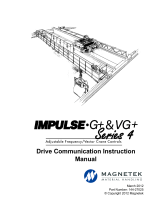
VLT
®
2800, VLT
®
6000 HVAC and VLT
®
8000 AQUA Modbus RTU
■Overview
■Introduction
These operating instructions provide comprehensive
instructions on the installation and set up of the
Modbus RTU for VLT
®
2800, VLT
®
6000 HVAC
and VLT
®
8000 AQUA Frequency Converter to
communicate over a Modbus network.
For specific information on installation and operation
of the frequency converter, refer to the VLT
®
2800
Operating Instructions, MG.28.AX.YY / VLT
®
6000
HVAC Operating Instructions, MG.61.AX.YY /
VLT
®
8000 Operating Instructions, MG.80.AX.YY.
■About This Manual
These operating instructions are intended to be used for
both instruction and reference. It only briefly touches on
the basics of the Modbus protocol whenever necessary
to gain an understanding of the Modbus RTU.
These operating instructions are also intended to
serve as a guideline when you specify and optimise
your communication system. Even if you are an
experienced Modbus programmer, it is suggested
that you read these operating instructions in its
entirety before you start programming since impor
tant
information can be found in all sections.
■Assumptions
These operating instructions assume that you have
a controller that supports the interfaces
in this
document and that all the requirements stipulated in
the controller, as well as the frequency converter, are
strictly observed, along with all l
imitations therein.
■What You Should Already Know
The Modbus RTU is designed to communicate with any
controller that supports the interfaces defined in this
document. It is assumed that yo
u have full knowledge
of the capabilities and limitations of the controller.
■Modbus RTU Overview
Modbus RTU (Remote Terminal Unit) protocol defines
a message structure that co
ntrollers will recognise
and use, regardless of the type of physical networks
over which they communicate. It describes the
process a controller use
s to request access to another
device, how it will respond to requests from the
other devices, and how errors will be detected and
reported. It establishes a common format for the
layout and contents of message fields.
During communications on a Modbus RTU network,
the protocol determines how each controller will know
its device address, recognise a message addressed
to it, determine the kind of action to be taken, and
extract any data or other information contained in
the message. If a reply is required, the controller will
construct the reply message and send it.
Controllers communicate using a master-slave
technique in which only one device (the master) can
initiate transactions (called queries). The other devices
(slaves) respond by supplying the requested data to the
master, or by taking the action requested in the query.
The master can address individual slaves, or can
initiate a broadcast message to all slaves. Slaves
return a message (called a response) to queries that
are addressed to them individually. Responses are not
returned to broadcast queries from the master.
The Modbus RTU protocol establishes the format
for the master’s query by placing into it the device
(or broadcast) address, a function code defi
ning
the requested action, any data to be sent, and an
error-checking field. The slave’s response message
is also constructed using Modbus pro
tocol. It
contains fields confirming the action taken, any data
to be returned, and an error-checking field. If an
error occurred in receipt of the m
essage, or if the
slave is unable to perform the requested action, the
slave will construct an error message and send it
in response or a time-out wi
ll occur.
MG.10.S2.02 - VLT is a registered Danfoss trademark
6





















